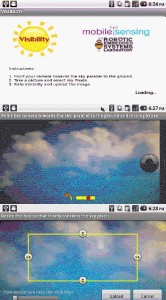Viterbi creates app to measure air quality
On Sept. 20, the USC Viterbi School of Engineering launched a new smartphone application, Visibility, which monitors air pollution. The application is an air visibility sensing system that allows the public to take a picture of the sky and observe the air quality.

Quality control· The Visibility application allows users to take a photo of the sky, and compare it to an ideal sky to determine the air quality. - Photo courtesy of the Viterbi School of Engineering
The idea of the application was the brainchild of Gaurav Sukhatme, a computer science professor in Viterbi. It was created under the Robotic Embedded Systems Laboratory at USC by Anoop Nimkar and Anupam Tulsyan, both graduate students studying computer science.
“Being L.A., air quality is something we always worry about,” said Sameera Poduri, a postdoctoral research associate at Viterbi who worked on the application. “A recent report by RAND has estimated that California paid about $200 million in air quality health costs over two years. To improve air quality, we have to be able to monitor it.”
She said Sukhatme and the students worked together to create the application.
“Gaurav suggested the air quality monitoring problem to me two years ago. I tried a few different ideas and decided on the current approach of comparing sky luminance models with images taken from mobile phones,” Poduri said.
The application compares images of the real sky to ideal images of what the sky should look like, Poduri said.
People who have seen the application are excited about the possibilities, said Eric Mankin, the media relations representative for Viterbi, and believe it will introduce a new system of obtaining results on public health information.
The system makes use of crowdsourcing — results from a large group of people that can drive a certain idea — and will allow researchers to receive continuously updated data on air quality from observers, since there are a sparse amount of current monitoring stations.
Visibility is a free application that can be used by anyone across the globe. Currently, it is only available for download on Android phone, though it will soon be available on the iPhone. Users aim the smartphone upward to take a picture of the sky, which is automatically sent to a central computer at USC for analysis.
Since the application is brand-new, there is still room for improvements, Poduri said. It’s not simply a point-and-click process; it might ask the user for a clearer image or position of the sky. Once the picture takes a clean image, it sends the time and location back to the servers at USC.
“Our current Visibility app is only a prototype,” Poduri said. “We want to make the app itself appealing and easy to use. A lot of these changes will be based on the data and feedback we are getting from users.”
Some students on campus said they felt that the Visibility application is a great idea. Some students expressed how the application will be beneficial for certain weekly activities.
“I definitely think the app is a great way to conduct research on the environment. Being from Santa Monica, where there is smog, would help me to determine whether it’s a good day to run or not,” said Evelina Weary, a sophomore majoring in public relations.
Although some students support the main idea of the application, they said it wouldn’t make a difference in their day-to-day activities.
“It sounds like a great tool for checking the pollution, but even if I test the quality, I still have to live with the results and go about my day,” said Morgan Tucker, a sophomore majoring in screenwriting.
The Visibility application is making progress, with more than 250 downloads so far. It can be downloaded online at the USC Robotics website or from an Android phone.
